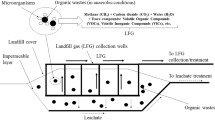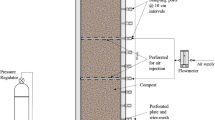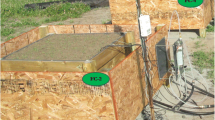Abstract
Coal mine methane is a significant greenhouse gas source as well as a potential lost energy resource if not effectively used. In recent years, mine ventilation air (MVA) capture and use has become a key element of research and development due to comparatively larger methane emissions by MVA than other coal mine sources. Technologies have been evaluated to treat the low methane concentrations in MVA such as thermal-based technologies or processing by biofiltration. This review initially considers the techniques available for treating the low methane concentrations encountered in MVA, after which it focuses on developments in biofiltration systems. Biofiltration represents a simple, energy-efficient, and cheap alternative to oxidize methane from MVA. Major factors influencing biofilter performance along with knowledge gaps in relation to its application to MVA are identified and discussed.


Similar content being viewed by others
References
Apel, W. A., Dugan, P. R., & Wiebe, M. R. (1991). Use of methanotrophic bacteria in gas phase bioreactors to abate methane in coal mine atmospheres. Fuel, 70(8), 1001–1003.
Arriaga, S., Muñoz, R., Hernández, S., Guieysse, B., & Revah, S. (2006). Gaseous hexane biodegradation by Fusarium solani in two liquid phase packed-bed and stirred-tank bioreactors. Environmental Science & Technology, 40(7), 2390–2395.
Australian Government Bureau of Meteorology (2011). Climate statistics for Australia locations. http://www.bom.gov.au/climate/averages/tables/cw_068053.shtml. Accessed 19 August 2011.
Bailón, L., Nikolausz, M., Kästner, M., Veiga, M. C., & Kennes, C. (2009). Removal of dichloromethane from waste gases in one-and two-liquid-phase stirred tank bioreactors and biotrickling filters. Water Research, 43(1), 11–20.
Bender, M., & Conrad, R. (1995). Effect of CH4 concentrations and soil conditions on the induction of CH4 oxidation activity. Soil Biology and Biochemistry, 27(12), 1517–1527.
Boeckx, P., & Cleemput, O. V. (1996). Methane oxidation in a neutral landfill cover soil: Influence of moisture content, temperature, nitrogen-turnover. Journal of Environmental Quality, 25(1), 178–183. doi:10.2134/jeq1996.00472425002500010023x.
Borjesson, G., Sundh, I., Tunlid, A., Frostegard, A., & Svensson, B. H. (1998). Microbial oxidation of CH4 at high partial pressures in an organic landfill cover soil under different moisture regimes. FEMS Microbiology Ecology, 26(3), 207–217.
Carothers, F. P., & Deo, M. (2000). Technical and economic assessment: Mitigation of methane emissions from coal mine ventilation air. Washington, DC: US EPA.
Carothers, F. P., Schultz, H. L., & Talkington, C. C. (2000). Mitigation of methane emissions from coal mine ventilation air: An update. Washington, DC: US EPA.
Chakravorty, R. N., & Forrester, P. I. Application of biotechnology for methane control in coal mines. In Second US Mine Ventilation Symposium, Reno, Nevada, USA, 23–25 September 1985 (pp. 699–706).
Chiemchaisri, W., Visvanathan, C., & Wu, J. S. (2001). Biological activities of methane oxidation in tropical landfill cover soils. J. Solid Waste Technol. Management, 27(3), 129–136.
Christophersen, M., Linderod, L., Jensen, P. E., & Kjeldsen, P. (2000). Methane oxidation at low temperatures in soil exposed to landfill gas. Journal of Environmental Quality, 29(6), 1989.
Cimino, S., Pirone, R., & Russo, G. (2001). Thermal stability of perovskite-based monolithic reactors in the catalytic combustion of methane. Industrial and Engineering Chemistry Research, 40(1), 80–85.
Cloirec, P. L., Humer, P., & Ramirez-Lopez, E. M. (2001). Biotreatment of odours: Control and performances of a biofilter and a bioscrubber. Water Science and Technology, 44, 219–226.
Cork, D., & Peet, R. (2011). Preliminary safety analysis for the connection of a thermal oxidiser to a working coal mine. Mayfield, Australia: Corky’s Sustainable Energy.
Cox, L., & Russell, D. (2003). Using bioreactors to control air pollution (vol. EPA-456/R-03-003). Washingon, DC: US EPA.
Dammann, B., Streese, J., & Stegmann, R. (1999). Microbial oxidation of methane from landfills in biofilters. In Proceedings Sardinia 99, 7th International Waste Management and Landfill Symposium, S.Margherita di Pula, Cagliari, Italy, 4–9 October (vol. 99, pp. 517–524). Silver Spring: Solid Waste Association of North America.
du Plessis, C. A., Strauss, J. M., Sebapalo, E. M. T., & Riedel, K.-H. J. (2003). Empirical model for methane oxidation using a composted pine bark biofilter. Fuel, 82(11), 1359–1365.
EPA. (2003). Assessment of the worldwide market potential fro oxidising coal mine ventilation air methane. Washington, DC: United States Environmental Protection Agency.
EPA. (2010). Coal mine methane country profile. Washington, DC: United States Environmental Protection Agency.
Gebert, J., & Groengroeft, A. (2006). Passive landfill gas emission—Influence of atmospheric pressure and implications for the operation of methane-oxidising biofilters. Waste Management, 26(3), 245–251.
Girard, M., Ramirez, A. A., Buelna, G., & Heitz, M. (2011). Biofiltration of methane at low concentrations representative of the piggery industry—Influence of the methane and nitrogen concentrations. Chemical Engineering Journal, 168, 151–158.
Groenestijn, J. W. V., & Kraakman, N. J. R. (2005). Recent developments in biological waste gas purification in Europe. Chemical Engineering Journal, 113, 85–91.
Hanson, R. S., & Hanson, T. E. (1996). Methanotrophic bacteria. Microbiological Reviews, 60(2), 439–471.
Hekmat, D., & Vortmeyer, D. (2000). Biodegradation of poorly water soluble volatile aromatic compounds from waste air. Chemical Engineering and Technology, 23(4), 315–318.
Hettiaratchi, J., & Stein, V. (2001). Methanobiofilters (MBFs) and landfill cover systems for CH4 emission mitigation. In Proceedings of the Seventeenth International Conference on Solid Waste Technology and Management, Philadelphia, PA (pp. 465–476).
Hettiaratchi, J., Stein, V., & Achari, G. (2000) Biofiltration: A cost-effective technique for controlling methane emissions. In Proceedings of the Sixth International Conference on Environmental Issues and Management of Waste in Energy and Mineral Production, Calgary, Alberta, Canada.
Higgins, I. J., Best, D. J., Hammond, R. C., & Scott, D. (1981). Methane-oxidizing microorganisms. Microbiological Reviews, 45(4), 556.
Humer, M., & Lechner, P. F. P. (1999). Alternative approach to the elimination of greenhouse gases from old landfills. Waste Management Res., 17(6), 443–452.
Hutsch, B. W. (1998). Methane oxidation in arable soil as inhibited by ammonium, nitrite, and organic manure with respect to soil pH. Biology and Fertility of Soils, 28(1), 27–35. doi:10.1007/s003740050459.
Kennes, C., Rene, E. R., & Veiga, M. C. (2009). Bioprocesses for air pollution control. Journal of Chemical Technology and Biotechnology, 84, 1419–1436. doi:10.1002/jctb.2216.
Kightley, D., Nedwell, D. B., & Cooper, M. (1995). Capacity for methane oxidation in landfill cover soils measured in laboratory scale soil microcosms. Applied and Environmental Microbiology, 61(2), 592.
King, G. M., & Schnell, S. (1994). Ammonium and nitrite inhibition of methane oxidation by Methylobacter albus BG8 and Methylosinus trichosporium OB3b at low methane concentrations. Applied and Environmental Microbiology, 60(10), 3508–3513.
Le Mer, J., & Roger, P. (2001). Production, oxidation, emission and consumption of methane by soils: A review. European Journal of Soil Biology, 37(1), 25–50.
Leak, D. J., & Dalton, H. (1986a). Growth yields of methanotrophs. Applied Microbiology and Biotechnology, 23(6), 470–476.
Leak, D. J., & Dalton, H. (1986b). Growth yields of methanotrophs 2. A theoretical analysis. Applied Microbiology and Biotechnology, 23(6), 477–481.
Lipscomb, J. D. (1994). Biochemistry of the soluble methane monooxygenase. Ann. Rev. Microbiol., 48(1), 371–399.
Melse, R. W., & van der Werf, A. W. (2005). Biofiltration for mitigation of methane emission from animal husbandry. Environmental Science & Technology, 39(14), 5460–5468.
Menard, C., Ramirez, A. A., Nikiema, J., & Heitz, M. (2011). Analysis of the effects of temperature, the amount of nutrient solution and the carbon dioxide concentration on methane biofiltration. Int. J. Sus. Dev. Plann, 6(3), 312–324.
Moore, S., Freund, P., Riemer, P., & Smith, A. (1998). Abatement of methane emissions. Cheltenham: IEA Greenhouse Gas R&D Programme.
Morton, J. D., Hayes, K. F., & Semrau, J. D. (2000). Effect of copper speciation on whole-cell soluble methane monooxygenase activity in Methylosinus trichosporium OB3b. Applied and Environmental Microbiology, 66(4), 1730–1733.
Myors, A. (2010). Methane capture from ventilation air. Sydney: Centennial Coal.
Nikiema, J., Bibeau, L., Lavoie, J., Brzezinski, R., Vigneux, J., & Heitz, M. (2004). Biogas, a real problem: Biofiltration, a promising solution. In Proceedings of the USCCSC-TRG Conference on Biofiltration, October, Los Angeles, California, USA, 20–22 October (pp. 73–80). Tustin: The Reynolds Group.
Nikiema, J., Bibeau, L., Lavoie, J., Brzezinski, R., Vigneux, J., & Heitz, M. (2005). Biofiltration of methane: An experimental study. Chemical Engineering Journal, 113(2–3), 111–117.
Nikiema, J., Brzezinski, R., & Heitz, M. (2007). Elimination of methane generated from landfills by biofiltration: A review. Reviews in Environmental Science and Biotechnology, 6(4), 261–284.
Nikiema, J., Brzezinski, R., & Heitz, M. (2010). Influence of phosphorus, potassium, and copper on methane biofiltration performance. Canadian Journal of Civil Engineering, 37, 335–345. doi:10.1139/L09-145.
Nikiema, J., Girard, M., Brzezinski, R., & Heitz, M. (2009). Biofiltration of methane using an inorganic filter bed: Influence of inlet load and nitrogen concentration. Canadian Journal of Civil Engineering, 36(12), 1903–1910.
Park, S., Brown, K. W., & Thomas, J. C. (2002). The effect of various environmental and design parameters on methane oxidation in a model biofilter. Waste Management Res, 20(5), 434.
Park, S. Y., Brown, K. W., & Thomas, J. C. (2004). The use of biofilters to reduce atmospheric methane emissions from landfills: Part I. Biofilter design. Water, Air, and Soil Pollution, 155(1), 63–85.
Qiao, F. (2007). Biofilter removal of methane from contaminated air. Dissertation, The State University of New Jersey, New Brunswick.
Ramirez, A. A., Jones, J. P., & Heitz, M. (2012). Methane treatment in biotrickling filters packed with inert materials in presence of a non-ionic surfactant. Journal of Chemical Technology and Biotechnology, 87, 848–853. doi:10.1002/jctb.3811.
Razumovsky, S. D., Efremenko, E. N., Makhlis, T. A., Senko, O. V., Bikhovsky, M. Y., Podmaster’ev, V. V., et al. (2008). Effect of immobilization on the main dynamic characteristics of the enzymatic oxidation of methane to methanol by bacteria Methylosinus sporium B-2121. Russian Chemical Bulletin., 57(8), 1633–1636.
Sloss, L. (2005). Coalbed methane emissions: Capture and utilisation. London: IEA Clean Coal Centre.
Sly, L. I., Bryant, L. J., Cox, J. M., & Anderson, J. M. (1993). Development of a biofilter for the removal of methane from coal mine ventilation atmospheres. Applied Microbiology and Biotechnology, 39(3), 400–404.
Smith, D. A. (2004). Methane recovery from low and variable concentrations in mine ventilation air: A review of adsorption and membrane separation (vol. C13077). Sydney: ACARP.
Solomon, S., Qin, D., Manning, M., Chen, Z., Marquis, M., Averyt, K. B., et al. (2007). Technical summary. In Climate change 2007: The physical science basis. Cambridge: Cambridge University Press.
Stralis-Pavese, N., Bodrossy, L., Reichenauer, T. G., Weilharter, A., & Sessitsch, A. (2006). 16S rRNA based T-RFLP analysis of methane oxidising bacteria—Assessment, critical evaluation of methodology performance and application for landfill site cover soils. Applied Soil Ecology, 31(3), 251–266.
Streese, J., & Stegmann, R. (2003). Microbial oxidation of methane from old landfills in biofilters. Waste Management, 23(7), 573–580.
Su, S., Beath, A., Guo, H., & Mallett, C. (2005). An assessment of mine methane mitigation and utilisation technologies. Progress in Energy and Combustion Science, 31(2), 123–170.
Su, S., Chen, H., Teakle, P., & Xue, S. (2008). Characteristics of coal mine ventilation air flows. J. Environ. Management, 86(1), 44–62.
Su, S., Ren, T., Balusu, R., Beath, A., Guo, H., & Mallett, C. (2006). Development of two case studies on mine methane capture and utilisation in China. Kenmore: Commonwealth Scientific and Industrial Research Organisation Exploration and Mining.
Su, S., & Yu, X. (2011). Progress in developing an innovative lean burn catalytic turbine technology for fugitive methane mitigation and utilization. Front. Energy, 5(2), 229–235. doi:10.1007/s11708-011-0147-9.
Trotsenko, Y. A., & Khmelenina, V. N. (2002). Biology of extremophilic and extremotolerant methanotrophs. Archives of Microbiology, 177(2), 123–131.
Veillette, M., Ramirez, A. A., & Heitz, M. (2012). Biofiltration of air polluted with methane at concentration levels similar to swine slurry emissions: Influence of ammonium concentration. Journal of Environmental Science and Health, Part A: Environmental Science and Engineering, 47(7), 1053–1064. doi:10.1080/10934529.2012.667327.
Venugopal, S., Chandrakanthi, M., Hettiaratchi, P. (2003). Field scale application of methanotrophic biofilters (MBFs) in treating methane emissions from oil and gas industry In 3rd International Methane and Nitrous Oxide Mitigation Conference, Beijing, China, 17–21 November (pp. 854–861).
Visvanathan, C., Pokhrel, D., Cheimchaisri, W., Hettiaratchi, J. P. A., & Wu, J. S. (1999). Methanotrophic activities in tropical landfill cover soils: Effects of temperature, moisture content and methane concentration. Waste Management Res., 17(4), 313–323.
Wang, Y., Man, C., & Che, D. (2010). Catalytic combustion of ventilation air methane in a reverse flow reactor. Energy Fuels, 24(9), 4841–4848. doi:10.1021/ef100528p.
Wani, A. H., Branion, R. M. R., & Lau, A. K. (1997). Biofiltration: A promising and cost-effective control technology for odors. VOCs and air toxics. J. Environ Sci. Health, 32(7), 2027–2055.
Warmuzinski, K. (2008). Harnessing methane emissions from coal mining. Process Safety and Environmental Protection, 86(5), 315–320.
Whalen, S. C., Reeburgh, W. S., & Sandbeck, K. A. (1990). Rapid methane oxidation in a landfill cover soil. Applied and Environmental Microbiology, 56(11), 3405.
Wilshusen, J. H., Hettiaratchi, J. P. A., & Stein, V. B. (2004). Long-term behavior of passively aerated compost methanotrophic biofilter columns. Waste Management, 24(7), 643–653.
Acknowledgments
This study is supported by the Australian Coal Association Research Program (Project C16048). The authors would like to thank Dr. Andrew Smith for his support during the project.
Author information
Authors and Affiliations
Corresponding author
Rights and permissions
About this article
Cite this article
Limbri, H., Gunawan, C., Rosche, B. et al. Challenges to Developing Methane Biofiltration for Coal Mine Ventilation Air: A Review. Water Air Soil Pollut 224, 1566 (2013). https://doi.org/10.1007/s11270-013-1566-5
Received:
Accepted:
Published:
DOI: https://doi.org/10.1007/s11270-013-1566-5




